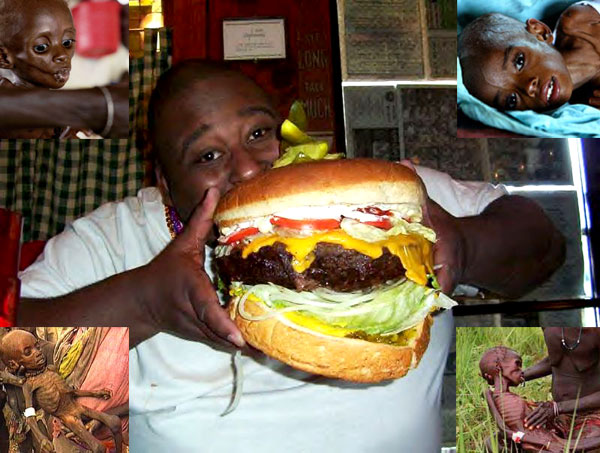Eighty percent of starving children live in countries that actually have food surpluses; the children remain hungry because farmers use the surplus grain to feed animals instead of people.
-
Number of people worldwide who will die as a result of malnutrition this year: 20 million
-
Number of people who could be adequately fed using land freed if Americans reduced their intake of meat by 10%: 100 million
-
Percentage of corn grown in the U.S. eaten by people: 20
-
Percentage of corn grown in the U.S. eaten by livestock: 80
-
Percentage of oats grown in the U.S. eaten by livestock: 95
-
Percentage of protein wasted by cycling grain through livestock: 90
-
How frequently a child dies as a result of malnutrition: every 2.3 seconds
-
Pounds of potatoes that can be grown on an acre: 40,000
-
Pounds of beef produced on an acre: 250
-
Percentage of U.S. farmland devoted to beef production: 56
-
Pounds of grain and soybeans needed to produce a pound of edible flesh from feedlot beef: 16
Our Environment
A vegetarian saves more than 100 animals and 1 acre of trees every year.
-
Fossil fuels needed to produce meat-centered diet vs. a meat-free diet: 3 times more
-
Percentage of U.S. topsoil lost to date: 75
-
Percentage of U.S. topsoil loss directly related to livestock raising: 85
-
Number of acres of U.S. forest cleared for cropland to produce meat-centered diet: 260 million
-
Amount of meat imported to U.S. annually from Central and South America: 300,000,000 pounds
-
Percentage of Central American children under the age of five who are undernourished: 75
-
Area of tropical rainforest consumed in every quarter-pound of rainforest beef: 55 square feet
-
Current rate of species extinction due to destruction of tropical rainforests for meat grazing and other uses: 1,000 per year
Our Health
Children who grow up getting their nutrition from plant foods rather than meats have a tremendous health advantage. They are less likely to develop weight problems, diabetes, high blood pressure, and some forms of cancer.
-
Most common cause of death in the U.S.: heart attack
-
How frequently a heart attack kills in the U.S.: every 45 seconds
-
Average U.S. man's risk of death from heart attack: 50 percent
-
Risk of average U.S. man who eats no meat: 15 percent
-
Risk of average U.S. man who eats no meat, dairy or eggs: 4 percent
-
Amount you reduce risk of heart attack if you reduce consumption of meat, dairy and eggs by 10 percent: 9 percent
-
Amount you reduce risk of heart attack if you reduce consumption by 50 percent: 45 percent
-
Amount you reduce risk if you eliminate meat, dairy and eggs from your diet: 90 percent
-
Average cholesterol level of people eating meat-centered-diet: 210 mg/dl
-
Chance of dying from heart disease if you are male and your blood cholesterol level is 210 mg/dl: greater than 50 percent
Our Natural Resources
You save more water by not eating a pound of beef than you do by not showering for an entire year.
-
User of more than half of all water used for all purposes in the U.S.: livestock production
-
Amount of water used in production of the average cow: sufficient to float a destroyer
-
Gallons of water needed to produce a pound of wheat: 25
-
Gallons of water needed to produce a pound of California beef: 5,000
-
Calories of fossil fuel expended to get 1 calory of protein from beef: 78
-
To get 1 calory of protein from soybeans: 2
-
Percentage of all raw materials (base products of farming, forestry and mining, including fossil fuels) consumed by U.S. that is devoted to the production of livestock: 33
-
Percentage of all raw materials consumed by the U.S. needed to produce a complete vegetarian diet: 2
Pesticides
According to leading scientists and the EPA, up to 95 percent of our dioxin exposure comes from red meat, fish, and dairy products. Even small amounts of dioxin can cause cancer, depressed immune response, nervous system disorders, miscarriages, and birth deformities.
-
Percentage of U.S. mother's milk containing significant levels of DDT: 99
-
Percentage of U.S. vegetarian mother's milk containing significant levels of DDT: 8
-
Contamination of breast milk, due to chlorinated hydrocarbon pesticides in animal products, found in meat-eating mothers vs. non-meat eating mothers: 35 times higher
-
Amount of Dieldrin ingested by the average breast-fed American infant: 9 times the permissable level











